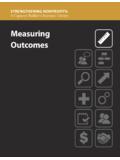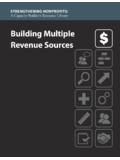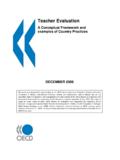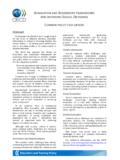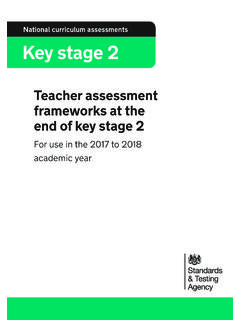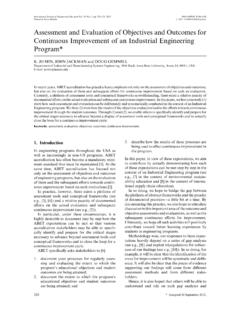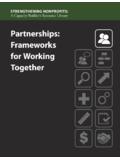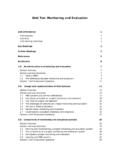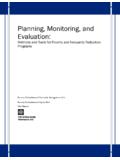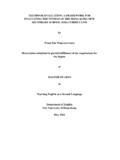Transcription of Conducting a Community Assessment
1 1 Conducting a Community AssessmentSTRENGTHENING NONPROFITS: A Capacity Builder s Resource LibraryTABLE OF CONTENTSINTRODUCTION ..3 OVERVIEW ..4 Community Needs ..4 Community Assets ..4 Why Should You Conduct a Community Assessment ? ..5 THE Community Assessment PROCESS ..5 Step 1: Define the Scope ..6 Step 2: Decide to Go Solo or Collaborate ..7 Step 3: Collect Data ..7 Step 4: Determine Key Findings ..8 Step 5: Set Priorities and Create an Action Plan ..9 Step 6: Share Your Findings ..10 ADDITIONAL RESOURCES ..11 APPENDICES ..12 APPENDIX A: Sample Memorandum of Understanding.
2 12 APPENDIX B: Worksheet: Creating a Data Collection Plan ..13 APPENDIX C: Locating Secondary Sources of Information ..14 APPENDIX D: Worksheet: Determining Key Findings ..16 APPENDIX E: Action Plan Template ..173 INTRODUCTIONThe Compassion Capital Fund (CCF), administered by the Department of Health and Human Services, provided capacity building grants to expand and strengthen the role of nonprofit organizations in their ability to provide social services to low-income individuals. Between 2002 and 2009, CCF awarded 1,277 grants, and the CCF National Resource Center provided training and technical assistance to all CCF grantees.
3 Strengthening Nonprofits: A Capacity Builder s Resource Library is born out of the expansive set of resources created by the National Resource Center during that time period, to be shared and to continue the legacy of CCF s capacity building work. Strengthening Nonprofits: A Capacity Builder s Resource Library contains guidebooks and e-learnings on the following topics:1. Conducting a Community Assessment2. Delivering Training and Technical Assistance3. Designing and Managing a Subaward Program4. Going Virtual5. Identifying and Promoting Effective Practices6. Leading a Nonprofit Organization: Tips and Tools for Executive Directors and Team Leaders7.
4 Managing Crisis: Risk Management and Crisis Response Planning8. Managing Public Grants9. Measuring Outcomes10. Partnerships: Frameworks for Working Together11. Sustainability12. Working with ConsultantsWho is the audience for Strengthening Nonprofits: A Capacity Builder s Resource Library?Anyone who is interested in expanding the capacity of nonprofit services in their Community from front line service providers to executives in large intermediary organizations will benefit from the information contained in this resource library. The National Resource Center originally developed many of these resources for intermediary organizations, organizations that were granted funds by CCF to build the capacity of the faith-based and Community -based organizations (FBCOs) they served.
5 As such, the majority of the resources in Strengthening Nonprofits: A Capacity Builder s Resource Library support intermediary organizations in their capacity building efforts. However, funders of capacity building programs (Federal program offices and foundations) and the nonprofit Community (including FBCOs) at large will also find these resources helpful. In addition, individuals working to build capacity within a program or an organization will be able to use these resources to support their efforts to implement change and make Conducting a Community Assessment guidebook will be helpful to any organization or coalition of organizations that wants to know what assets and needs exist within its developed the Conducting a Community Assessment guidebook?
6 The guidebook was originally developed for the CCF Communities Empowering Youth Program by the National Resource Center. It was updated in 2010 for the Department of Health and Human Services by the National Resource Center. 4 OVERVIEWIn order to effectively serve a Community , it is important to understand the Community . This understanding can be achieved through a Community Assessment . The findings from an Assessment will define the extent of the needs that exist in a Community and the depth of the assets available within the Community to address those needs. This understanding of needs and assets can be used to strategically plan and deliver relevant, successful, and timely NeedsThe University of Kansas (KU) Work Group for Community Health and Development defines Community needs as the gap between what a situation is and what it should Examining needs helps us discover what is lacking, and points us in the direction of future improvement.
7 1 A goal of a Community Assessment is to develop an informed understanding of the gaps or needs that exist within a Community and their impacts upon the Community s members. Low high school graduation rates indicate a need to find effective ways to keep kids in school. Senior citizens are living longer, but that may mean that many need more assistance to pay for medical bills or prescription drugs. In communities where pet owners want more park space but sports leagues want the same space for playing fields, there is a need to balance competing interests. Community needs can affect a large or small number of a Community s members: families, individuals, youth, seniors, parents, businesses, Community organizations, faith-based organizations, anyone who claims membership in the Community .
8 Of course, if Community needs affect a large number of Community members, there will be more support for addressing the needs. Sometimes Community needs are referred to as Community problems. This reference should be avoided in Community assessments. Framing a need as a problem immediately establishes an us versus them relationship that prevents collaboration and Community AssetsCommunity assets are defined as those things that can be used to improve the quality of life. 2 Another goal of a Community Assessment is to develop a detailed analysis of Community assets, or resources, that currently exist in the Community and can be used to help meet Community needs.
9 Community assets include organizations, people, partnerships, facilities, funding, policies, regulations, and a Community s collective experience. Any positive aspect of the Community is an asset that can be leveraged to develop effective solutionsTwo approaches can be used to identify Community assets. The first approach is to identify the assets that are already known for supporting Community needs. This includes Community organizations and individuals that currently provide services to Community members or have provided financial support to address the needs.
10 Organizations that provide after-school programs to help youth graduate on time would be included in a Community Assessment focused on keeping kids in school. Clinics that offer free medical services to low-income seniors should be identified in a Community Assessment of seniors who need medical financial assistance. 1 Catie Heaven, Developing a Plan for Identifying Local Needs and Resources, Community Tool Box (Lawrence, KS: KU Work Group for Community Health and Development, 2010), 2 second approach to identifying Community assets builds upon the experiences of other communities to highlight resources that may be available.
